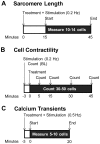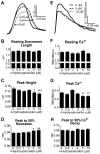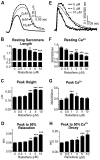Direct, differential effects of tamoxifen, 4-hydroxytamoxifen, and raloxifene on cardiac myocyte contractility and calcium handling
- PMID: 24205315
- PMCID: PMC3811994
- DOI: 10.1371/journal.pone.0078768
Direct, differential effects of tamoxifen, 4-hydroxytamoxifen, and raloxifene on cardiac myocyte contractility and calcium handling
Abstract
Tamoxifen (Tam), a selective estrogen receptor modulator, is in wide clinical use for the treatment and prevention of breast cancer. High Tam doses have been used for treatment of gliomas and cancers with multiple drug resistance, but long QT Syndrome is a side effect. Tam is also used experimentally in mice for inducible gene knockout in numerous tissues, including heart; however, the potential direct effects of Tam on cardiac myocyte mechanical function are not known. The goal of this study was to determine the direct, acute effects of Tam, its active metabolite 4-hydroxytamoxifen (4OHT), and related drug raloxifene (Ral) on isolated rat cardiac myocyte mechanical function and calcium handling. Tam decreased contraction amplitude, slowed relaxation, and decreased Ca²⁺ transient amplitude. Effects were primarily observed at 5 and 10 μM Tam, which is relevant for high dose Tam treatment in cancer patients as well as Tam-mediated gene excision in mice. Myocytes treated with 4OHT responded similarly to Tam-treated cells with regard to both contractility and calcium handling, suggesting an estrogen-receptor independent mechanism is responsible for the effects. In contrast, Ral increased contraction and Ca²⁺ transient amplitudes. At 10 μM, all drugs had a time-dependent effect to abolish cellular contraction. In conclusion, Tam, 4OHT, and Ral adversely and differentially alter cardiac myocyte contractility and Ca²⁺ handling. These findings have important implications for understanding the Tam-induced cardiomyopathy in gene excision studies and may be important for understanding effects on cardiac performance in patients undergoing high-dose Tam therapy.
Conflict of interest statement
Figures







References
Publication types
MeSH terms
Substances
Grants and funding
LinkOut - more resources
Full Text Sources
Other Literature Sources
Medical
Miscellaneous

